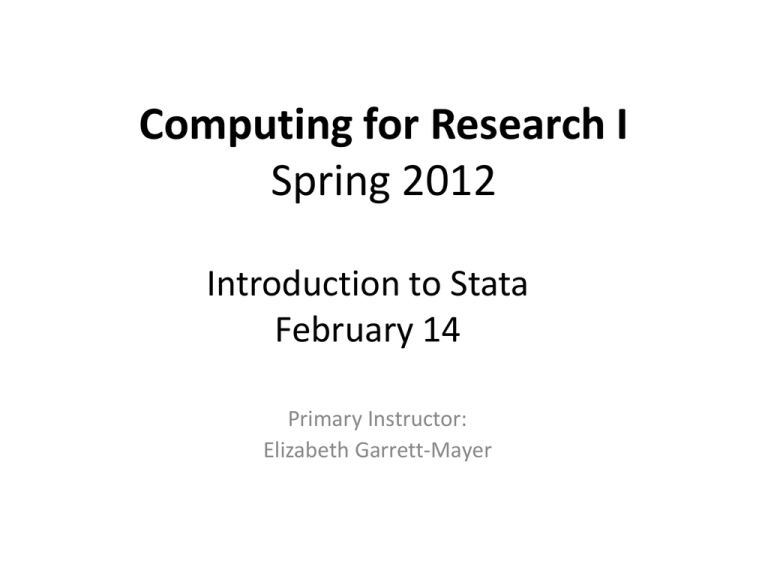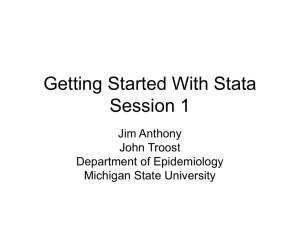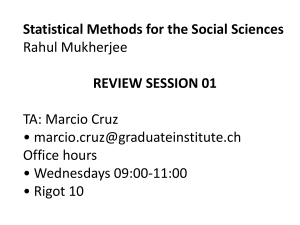Stata1
advertisement

Computing for Research I Spring 2012 Introduction to Stata February 14 Primary Instructor: Elizabeth Garrett-Mayer Stata • Stata is a powerful statistical package with – smart data-management facilities – a wide array of up-to-date statistical techniques, – an excellent system for producing publication-quality graphs. • Stata is fast and easy to use • Current version is Stata 11. • Stata vs. Stata SE – “standard” stata can handle up to 2047 variables – SE can handle 32766 variables – Number of observations is limited by your computer (up to 2 billion!) Stata Interface • Multiple Windows – – – – Results Review Variables Command • Other windows – – – – Data editor Data viewer Log ‘do’ Stata Interface • • • • • • Customizable windows Can be resized Edits to preferences are ‘remembered’ You can save (then load) different preferences. Command line driven But more recently, drop-down menu Important Details • • • • • • case sensitive! return means ‘run’. there is no little running man to click. you cannot run commands if your data editor is open you need to ‘clear’ data before you bring in more data you can only have one dataset active at a time Save yourself some typing (and errors) – Utilize the variables window – Utilize the ‘command’ window • abbreviations work for commands and variable names! – d instead of describe – case instead of caseid – NOT always, but if they uniquely identify variable name or command, they should – Also true for some options. – See Stata help files for how short you can go on abbreviations Help!! • The most important part • Two interactive options: – help ‘command’ – help ‘search’ • Also LARGE pdfs that link from help files • Plus: – – – – advice link to Stata command line help findit No data? • There are lots of things you can do without data in stata! • “immediate” commands – An immediate command is a command that obtains data not from the data stored in memory but from numbers typed as arguments. – Immediate commands, in effect, turn Stata into a glorified hand calculator. Some immediate commands bitesti cci csi iri mcci cii prtesti sampsi sdtesti symmi tabi ttesti twoway scatteri twoway pci twoway pcarrowi display Binomial probability test Tables for epidemiologists; see [ST] epitab Confidence intervals for means, proportions, counts One- and two-sample tests of proportions Sample size and power determination Variance comparison tests Symmetry and marginal homogeneity tests One- and two-way tables of frequencies Mean comparison tests Scatterplot Paired-coordinate plot with spikes or lines Paired-coordinate plot with arrows see ‘help immediate’ for more information Some examples display 4.1–1.96*0.3 tabi 100 34 \ 17 294 tabi 100 34 \ 17 294, col tabi 100 34 \ 17 294, col row cell chi cci 100 34 17 294 cci 100 34 17 294, exact sampsi 0.2 0.5 But most of the time, we have datasets • *.dta files are stata datasets • To open: – Option 1: use the “use” command: • use "I:\MUSC Oncology\Cunningham, Joan\June2007\SCbcdata.dta“ – Option 2: menu-driven open • File Open… • If you use Option 2, the associated command will appear in your results window AND in your review window • If you use Option 2, consider cutting and pasting command into your ‘do’ file for next time.. Other types of data? • Stata can import – ASCII files – Sas export – and a few others (that I have never heard of) • Two options: – menu-driven: File Import…. – insheet command can be used for ascii files • insheet using sampledata.csv, comma • insheet using sampledata.csv, tab – you can use any separator (use delimiter(“char”) option) Two notes on opening files • if you use command line, you will have to either add clear at the end of the line to clear a current data set, or type clear as a command prior to opening the new dataset – insheet using sampledata.csv, comma clear OR – clear – insheet using sampledata.csv, comma • you can use the cd command to tell Stata where to browse for your file(s), instead of giving long path names. This is particularly helpful if you are merging files from the same directory – cd “I:\Classes\StatComputingI” Example: SC breast cancer registry data from 2004 • All diagnoses of breast cancer in SC are recorded • N = 2633; 55 variables • Demographic and clinical information recorded • Let’s read it in and explore it – use cd – use insheet – use ‘use’ Exploring your dataset • • • • • describe (can be abbreviated ‘d’) – a very good idea to make sure things look right – tell you about types of variables, number of observations and number of variables codebook – summary per variable – useful for seeing number of uniques and missings sum – statistical summary (N, mean, SD, etc.) – only works on numerically coded variables – sum, detail inspect – similar to codebook. – provides rough histogram and neg, pos, missing Note: – all of these can be used with or without a varlist (e.g. sum race age) – to ‘quit’ a long command, type ‘q’ and it will stop sending output to results window Exploring your dataset • • • • Open dataset in editor or browser Difference? edit capabilities Allows you to sort Variables manager (can access from viewer or main toolbar) – allows you to add labels simply – includes coding Exploring • Categorical variables can be summarized using tabulate (tab) or tabulate – tab race – table race • list can help with a small dataset, or to look at a subset of the dataset – list race age if age<30 • Can also sort at command line – sort age Interactive command line driven? • Well, there is a little running man, afterall! • GOOD PROGRAMMING PRACTICE: – – – – open a ‘do’ file enter all of your commands in the do file you can select one or more to run at a time SAVE your do file!!! • Window Do File Editor • how to include comments? * or /*…*/ * this is how we can make a table of race and ER tab race ercat /* our table looks very nice. we should really make pretty tables all the time */ Do file of our commands so far * slide 13: reading in data cd "I:\Classes\StatComputingI" insheet using "SCBC2004.csv", comma clear use SCBC2004.dta * slide 14: exploring our dataset * use d or describe d d ercat codebook codebook dodyr sum sum ercat codebook ercat * slide 16: more exploration tab race table race list race age if age<30 sort age What about the output? • • • • • Sometimes you want to have a file that shows the results Useful to share with investigators(?) Nice to have output saved My preference? keep a really good ‘do’ file and rerun it. Log file setup steps: – File Log Begin – analyze data, etc. – File Log Suspend (or End) • Options for text (.log) or formatted (.smcl) files – *.log can be opened in text editor – *.smcl can only be opened in stata but looks nicer (and can be printed from stata) Getting stuff out of Stata • Stata can be good for data management • I prefer it to R – step 1: data management in Stata – step 2: write ‘clean’ file from Stata to csv – step 3: read clean file into R • Exporting: – menu-driven: File Export – command line: outsheet [varlist] using “file.csv”, comma **for command line, may need “replace” as an option if you already have a file of the same name you want to replace. Saving Stata Data • File Save or Save as • Command line: – save “filename”, replace – save filename – save filename.dta – .dta will be added – replace may be needed or not What if you don’t want to save or export everything? • You can use keep and drop commands to keep or drop observations or variables before exporting/saving • Want analyze ER, PR status, stage, age and grade in African American women. – drop if race==1 – keep ercat prcat stagen age grade • These observations and variables are GONE from Stata’s memory • If you want them back, you need to reload the original data • BE CAREFUL: do NOT drop variables or observations and then overwrite original data! Other options for subsetting • by: performs command by categories – by race, sort: sum age – bysort ercat prcat: sum age • if: performs command in a category/range – tab ercat if stagen>1 – tab ercat if graden~=. • Combine them: – bysort ercat prcat: sum age if ercat<9 & prcat<9 Working with variables • new variables can be created with the ‘generate’ command (or just ‘gen’) • Example: grade has 4 levels . tab graden graden | Freq. Percent Cum. ------------+----------------------------------1 | 468 19.45 19.45 2 | 916 38.07 57.52 3 | 941 39.11 96.63 4 | 81 3.37 100.00 ------------+----------------------------------Total | 2,406 100.00 • We want to create high vs low grade variable Several approaches • gen highgrade = 1 if graden>2 • replace highgrade = 0 if graden<3 • gen highgrade=cond(graden>2,1,0) • replace highgrade = . if graden==. • Note well: Check coding of missing values!! Extensions to generate • ‘egen’ • Same example: egen has a function ‘cut’ that can cut a continuous variable at a list of breakpoints: • categories are defined by < each breakpoint egen highgrade=cut(graden), at(-1,3,5) egen highgrade=cut(graden), at(-1,3,5) icodes generate • use it for transformations – gen y = log(x) – gen y = x^2 • generate random variables – gen z1 = uniform() – gen z2 = 2 + 2*runiform() uniform(2,4) * • generate ascending observation id – gen id= _n – bysort county: gen countyid=_n Example of using these commands together • We want to randomly select 10 women from each of 46 counties in SC • Step 1: generate random numbers – gen z1=runiform() • Step 2: sort and number women within counties – sort county z1 – by county : gen countyid=_n • Step 3: keep only 10 women in county – drop if countyid>10 Formatting Dates • Dates do not always maintain formatting, especially when reading data from csv files • Two steps: generate and format • Example stata syntax – gen newdate=date(datevar, “MDY”) – format newdate %td • Stata treats dates as integers (formatting is like labels) so they can be manipulated • Month, day and year can be extracted • Also, see clock • There are a lot of details that can be found in the help file Reshaping Data • In Stata there is one command to reshape IF your data is in the right format. • From long to wide: – i indexes the observation (e.g., patient, hospital) – j indexs the repeats (e.g., year, cycle, visit) – Also need to list which variables vary by j Example: ceramide data • Clinical trial in cancer patients • Ceramide (et al.) were measured every two cycles in patients • Of interest: do changes in ceramide correlate with outcome (e.g., response, survival)? • Data provided in long format – – – – i is patient_id j is cycle Ceramide, etc. vary per patient Some variables are constant (and stata can figure it out!) Reshaping ceramide data • reshape wide collecteddate frombaselines1p, i(patient) j(cycle) • reshape long: once Stata reshapes data in its recent memory, it can reshape again without any options Reshaping wide to long • Much more common • Many researchers “grow” their datasets by columns instead of rows • Formatting needs to be specific – Variable names must have numeric suffix – Could require a fair amount of editing – Depends on how many repeats and variables there are Reshaping wide to long clear insheet using "ceramide2.csv" rename cycle1totalceramidelevels totalceramidelevels1 rename cycle1diseasestatus diseasestatus1 rename cycle1c18ceramide c18ceramide1 rename cycle3totalceramidelevels totalceramidelevels3 rename cycle3diseasestatus diseasestatus3 rename cycle3c18ceramide c18ceramide3 rename cycle5totalceramidelevels totalceramidelevels5 rename cycle5diseasestatus diseasestatus5 rename cycle5c18ceramide c18ceramide5 rename cycle3daysfromstart daysfromstart3 rename cycle5daysfromstart daysfromstart5 reshape long daysfromstart diseasestatus totalceramidelevels c18ceramide , i(patient) j(cycle) drop if totalcerami==. replace daysfromstart=0 if cycle==1






